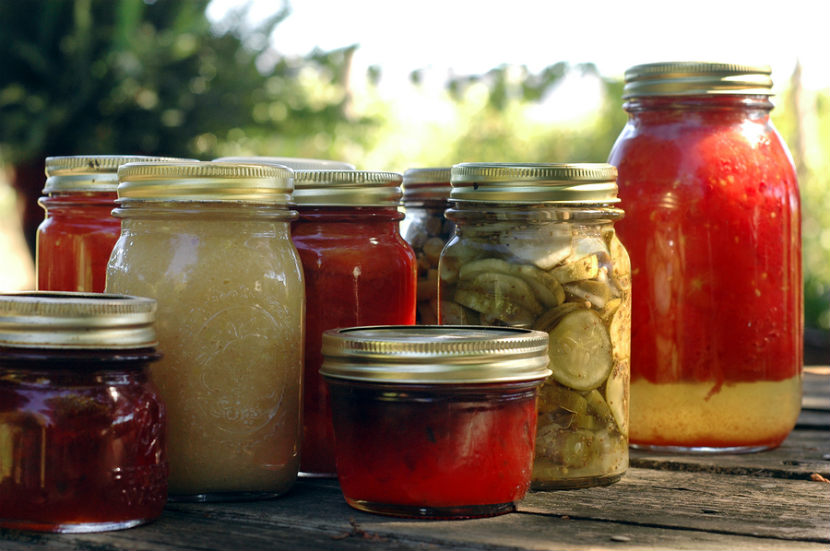
If you are new to home canning, here are some tips to help get you started. This article does not cover all the steps in the canning process, but is meant to give you a head start while you learn about home canning.
How do I get started with home canning?
There are two main ways to can food depending on if the food is high or low acid. High and low acid foods need to be canned differently to prevent harmful bacteria from growing.
-
High acid food like fruit is canned with a boiling water canner. If you want to make jams, sauerkraut, pickles, relishes, chutneys, condiments or fruit butters use a boiling water canner.
-
Low acid food like meat, seafood or vegetables (except tomatoes*) need to be processed at higher temperatures to kill bacteria. They are canned with a pressure canner.
*Note: When tomatoes are being prepared for canning, an acid (such as vinegar) must be added to them to make them safer for preserving.
What’s the difference between a boiling water canner and a pressure canner?
Boiling water canner
A boiling-water canner is a large pot made of aluminum or porcelain covered steel. It comes with removable racks (for resting the jars) and a fitted lid. You can make your own boiling water canner or purchase one. To make your own: You will need a deep pot with a tight fitting lid. The pot should be able to hold the canning jars with extra space for 3-5 centimetres (1-2 inches) of water. A cake rack can be used for resting the jars on the bottom of the pot.
Pressure canner
A pressure canner is an aluminum pot with a locking lid. It comes with a jar rack, pressure gauge and a steam vent. The pressure creates steam that raises the temperature of the pot so that low acid foods can be preserved safely. Follow the instruction manual that comes with your pressure canner. The pressure gauge must be checked every year to make sure that the canner is working at the right pressure. Pressure canners are not the same as pressure cookers. Note: Some older canning practices are no longer thought to be safe.
Where can I get recipes for home canning?
Visit the National Center for Home Food Preservation for tested recipes. Tested recipes have the right amount of acid and moisture to keep your foods safe. Never change a recipe in any way such as:
-
Amounts or types of ingredients
-
Jar size
-
Processing time
-
Pressure levels
This can make it easier for bacteria to grow and make your food unsafe to eat.
What home canning equipment do I need to get started?
You will need:
-
A boiling water canner for high acid food or a pressure canner for low acid food.
-
Proper canning jars made for home canning. Empty jars from store bought foods like mayonnaise jars are not sturdy enough.
-
A wide-mouth funnel to avoid spills.
-
A jar lifter for placing your jars in and out of the boiling-water or pressure canner.
-
A small spatula to get rid of air bubbles in food.
How long should jars be boiled to be safe for home canning?
Always follow the recipe instructions. Boiling time depends on many factors such as the type and quantity of food, the canning method, the size of jars, and even the altitude.
How do I know if my jars have sealed properly?
Let the jars cool for 24 hours. Remove the metal screw bands on the jars and try these tests:
-
Press the middle of the lid with your finger. If the lid springs back up, it is not sealed properly.
-
Hold the jar at eye-level. A flat or bulging lid has not sealed properly. A properly sealed lid dips down slightly in the centre.
-
Tap the lid with the bottom of a teaspoon. If you hear a dull sound, it is not sealed properly. A properly sealed jar makes a ringing, high-pitched noise.
If the jar has not sealed properly, you can:
-
Re-process the food again within 24 hours. Check the jar and lid for nicks or cracks. Replace if needed. Clean any food off the rim of the jar. It needs to be clean to seal properly. Use the same cooking time listed in the recipe.
-
Freeze the food. Cool the food quickly in a shallow dish stored in the fridge, then freeze it.
-
Store food in the fridge. Eat within a few days.
Find out more about cooling jars and testing seals.
How long can I store my canned foods?
Canned foods can be stored for one year. Store canned food in a clean, cool (between 50-70°F or 10-20°C) dark, dry place. Label and date canned food with a “use by” date (one year from when you canned it).
How do I know if my canned food may have spoiled?
If your food has foamed, smells “bad” while cooking, or the container has a bulging lid, throw it out right away. Wash your hands, equipment, utensils and work surfaces with warm soapy water. If your jar has an unsealed lid, throw it out. The toxin that causes botulism (severe food poisoning) will not change the colour, taste or smell of food.
Where can I go to learn the steps in home canning?
If you are new to canning or have not canned in a long time, try taking a canning course or canning with someone who does it frequently.
You can also check out the resources below:
Tutorials and videos on canning, National Centre for Home Food Preservation
How do I can? National Centre for Home Food Preservation
Guiding Principles of Home Canning, United States Department of Agriculture
You may also be interested in
Introduction to home canning
Home Canning: How to Avoid Botulism, BC Health Guide Program
Home canning safety, Government of Canada
Last Update – June 13, 2018